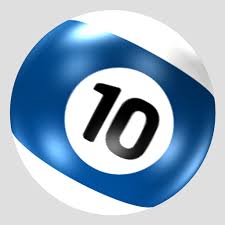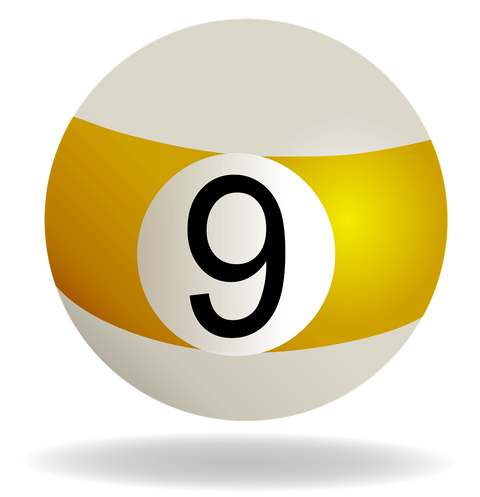How to Play 10-ball Pool
How to Play 10-ball, Call Your Ball, Call Your Hole, Take Your Shot!
We all love a challenge! Don’t we? When things become a bit predictable it seems to be human nature to want something a bit tougher.
This explains why the game of 10-ball is coming on strong in the face of the nine-ball onslaught.
Some professionals simply think 10-ball is more of a challenge than nine-ball which they consider to be predictable off the break.
So the cue-sport game is in a constant state of flux which fits in nicely with Greek philosopher Heraclitus who around 500 BC pondered that all things pass and nothing stays. To explain this theory he said you could not step twice into the same river.
Applying this theory to cue-sport you have a much lesser chance of playing the same game twice in 10-ball as you would in nine-ball.
Here’s why.
10-Ball uses ten balls instead of nine and the Blue Number 10 ball is, to put it into eight-ball terms, the black ball – the money ball!
And here’s why the professionals have a greater liking for the game – all shots must be called and you have to pocket the balls in numerical order. You only call one ball at a time but if there is any confusion about your shot you must nominate the pocket. If your intention is not to sink the object ball you can call a safety. A safety is called when you see no hope in sinking the object ball.
Any additional balls pocketed from a legal shot remain pocketed.
Like the standard pool, all ten balls are racked as a triangle but the ten-ball is in the middle of the rack, and the one-ball is at the top of the track with all the other balls placed randomly.

From the break, the opening shot must hit the lowest-numbered ball first, which is why the one-ball is at the top. At least one ball must hit any rubber.
If the 10 ball is pocketed on the break you don’t win. It has to be spotted on the foot spot but you are not penalised and continue on with your turn.
However, if you pocket the wrong ball or hit the nominated ball into the wrong pocket, the ball stays down. The applied penalty for doing this is your opponents can either take the shot as it lies or pass.
For a standard foul, play passes to your opponent who can place the cue ball anywhere on the table.
If several fouls occur in one shot, the most serious one is enforced. If a foul goes unnoticed before the next shot – you’ve got away with it.
The following is a list of what constitutes a standard foul by the World Pool-Billiard Association:
Cue Ball Scratch or Off the Table: If the cue ball is pocketed or driven off the table, the shot is a foul.
Wrong Ball First: In those games that require the first object ball struck to be a particular ball or one of a group of balls, it is a foul for the cue ball to first contact any other ball.
No Rail after Contact: If no ball is pocketed on a shot, the cue ball must contact an object ball, and after that contact at least one ball (cue ball or any object ball) must be driven to a rail, or the shot is a foul.
No Foot on Floor: If the shooter does not have at least one foot touching the floor at the instant the tip contacts the cue ball, the shot is a foul.
Ball Driven off the Table: It is a foul to drive an object ball off the table. Whether that ball is spotted depends on the rules of the game.
Touched Ball: It is a foul to touch, move or change the path of any object ball except by the normal ball-to-ball contacts during shots. It is a foul to touch, move or change the path of the cue ball except when it is in hand or by the normal tip-to-ball forward stroke contact of a shot.
The shooter is responsible for the equipment he controls at the table, such as chalk, bridges, clothing, his hair, parts of his body, and the cue ball when it is in hand, that may be involved in such fouls. If such a foul is accidental, it is a standard foul, but if it is intentional, it is Unsportsmanlike Conduct.
Double Hit / Frozen Balls: If the cue stick contacts the cue ball more than once on a shot, the shot is a foul. If the cue ball is close to but not touching an object ball and the cue tip is still on the cue ball when the cue ball contacts that object ball, the shot is a foul.
If the cue ball is very close to an object ball, and the shooter barely grazes that object ball on the shot, the shot is assumed not to violate the first paragraph of this rule, even though the tip is arguably still on the cue ball when ball-ball contact is made.
However, if the cue ball is touching an object ball at the start of the shot, it is legal to shoot towards or partly into that ball (provided it is a legal target within the rules of the game) and if the object ball is moved by such a shot, it is considered to have been contacted by the cue ball. (Even though it may be legal to shoot towards such a touching or “frozen” ball, care must be taken not to violate the rules in the first paragraph if there are additional balls close by.)
The cue ball is assumed not to be touching any ball unless it is declared touching by the referee or opponent. It is the shooter’s responsibility to get the declaration before the shot. Playing away from a frozen ball does not constitute having hit that ball unless specified in the rules of the game.
Push Shot: It is a foul to prolong tip-to-cue-ball contact beyond that seen in normal shots.
Balls Still Moving: It is a foul to begin a shot while any ball in play is moving or spinning.
Bad Cue Ball Placement: When the cue ball is in hand and restricted to the area behind the head string, it is a foul to play the cue ball from on or below the head string. If the shooter is uncertain whether the cue ball has been placed behind the head string, he may ask the referee for a determination.
Bad Play from Behind the Head String: When the cue ball is in hand behind the head string, and the first ball the cue ball contacts is also behind the head string, the shot is a foul unless the cue ball crosses the head string before that contact. If such a shot is intentional, it is unsportsmanlike conduct. The cue ball must either cross the head string or contact a ball in front of or on the head string or the shot is a foul, and the cue ball is in hand for the following player according to the rules of the specific game.
Cue Stick on the Table: If the shooter uses his cue stick in order to align a shot by placing it on the table without having a hand on the stick, it is a foul.
Playing out of Turn: It is a standard foul to unintentionally play out of turn. Normally, the balls will be played from the position left by the mistaken play. If a player intentionally plays out of turn, it should be treated like 6.16 Unsportsmanlike Conduct.
Three Consecutive Fouls: If a player fouls three times without making an intervening legal shot, it is a serious foul. In games scored by the rack, such as nine balls, the fouls must be in a single rack. Some games such as eight ball do not include this rule. The referee must warn a shooter who is on two fouls when he comes to the table that he is on two fouls. Otherwise, a possible third foul will be considered to be only the second.
Slow Play: If the referee feels that a player is playing too slowly, he may advise that player to speed up his play. If the player does not speed up, the referee may impose a shot clock on that match that applies to both players. If the shooter exceeds the time limit specified for the tournament, a standard foul will be called and the incoming player is rewarded according to the rules applicable to the game being played. (Unsportsmanlike Conduct may also apply.)
Unsportsmanlike Conduct: The normal penalty for unsportsmanlike conduct is the same as for a serious foul, but the referee may impose a penalty depending on his judgment of the conduct.
Among other penalties possible are a warning; a standard-foul penalty, which will count as part of a three-foul sequence if applicable; a serious-foul penalty; loss of a rack, set or match; ejection from the competition possibly with forfeiture of all prizes, trophies and standings points. Unsportsmanlike conduct is any intentional behaviour that brings disrepute to the sport or disrupts or changes the game to the extent that it cannot be played fairly.
It includes:
(a) distracting the opponent;
(b) changing the position of the balls in play other than by a shot;
(c) playing a shot by intentionally miscuing;
(d) continuing to play after a foul has been called or play has been suspended;
(e) practising during a match;
(f) marking the table;
(g) delay of the game; and
(h) using equipment inappropriately.
Why the fouls may seem a lot to deal with in the game is really very easy to pick up. If you like a challenge and are looking for a change from whatever form of cue sport, 10-ball is a fantastic alternative.
It is a longer game than eight or nine-ball and forces you to play a more tactical game.

Here is a pic of Taiwan’s Ko Pin Yi winning his first-ever world title by capturing the 2015 World 10 Ball Championship with a dramatic 11-9 win over the Philippines Carlo Biado.
Let the good times roll!
Video tutorial - How to Play 10-Ball Pool
Some Pool Balls in Our Range
*If you want to purchase these for your store, contact us at palko.com.au for wholesale prices




